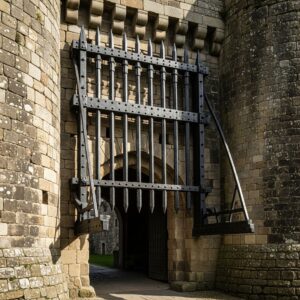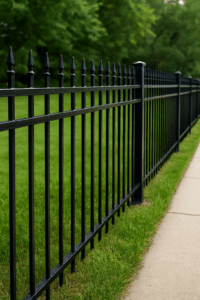Welcome to our step-by-step guide on building a fence around your existing swimming pool! Whether you’re a seasoned DIY enthusiast or a first-timer ready to roll up your sleeves, this project is perfectly manageable with a bit of planning and effort. Besides enhancing the safety of your pool area, adding a fence can significantly improve its aesthetics, turning your backyard into a private oasis. With the right tools, materials, and a weekend’s worth of work, you’ll not only increase the value of your home but also create a safer and more beautiful space for your family to enjoy. Let’s dive in and make your swimming pool area both secure and stylish!
Why Add a Fence?
Safety First: The primary reason to install a fence around your pool is safety. If you have young children, pets, or frequently host guests, a fence is essential to prevent accidental falls into the pool. It acts as a physical barrier that can save lives by reducing the risk of drowning accidents.
Legal and Insurance Requirements: Many local governments have strict regulations requiring pool owners to install fences as a safety measure. These laws vary by location but often include specifications on the fence’s height, material, and gate locks. Failing to comply not only poses a safety risk but can also lead to fines and complications with your home insurance. Speaking of insurance, many providers may lower your premiums or require a fence for coverage, acknowledging the reduced risk of accidents.
Aesthetics and Privacy: Beyond safety and compliance, a fence can significantly enhance the appearance and privacy of your pool area. With a variety of materials and designs available, you can choose a fence that complements your home’s exterior and landscaping. Whether you opt for a classic wood fence, a modern glass barrier, or anything in between, a well-chosen fence can transform your pool area into a secluded retreat, perfect for relaxation and entertainment.
Adding a fence around your swimming pool is more than a weekend project; it’s an investment in safety, compliance, and beauty. Let’s move forward and discuss how to select the best materials and design for your new pool fence.
Planning Your Pool Fence
Choosing the Right Materials
Selecting the material for your pool fence is like picking the right ingredient for your favorite recipe—it needs to be just right. Here’s a rundown of your options:
- Wood: A classic choice that offers warmth and natural beauty. It can be painted or stained to match your backyard decor. However, it requires regular maintenance to prevent rot and wear.
- Vinyl: Low maintenance and durable, vinyl fencing comes in various styles. It won’t rot or rust, but intense heat can make it more susceptible to damage over time.
- Aluminum: Lightweight and rust-proof, aluminum fencing offers a sleek, modern look with minimal upkeep. It’s not as private as wood or vinyl, given its typical picket design.
- Glass: For those who don’t want to obstruct the view of their beautiful pool, glass fencing is ideal. It’s chic and durable but comes with a higher price tag and needs regular cleaning to keep it sparkling.
Determining the Fence Height
The height of your fence isn’t just about aesthetics or keeping the dog in—it’s also about adhering to local regulations, which often specify minimum heights for safety. Generally, pool fences should be at least 4 feet high, but checking with your local regulations will ensure you’re within guidelines. Consider your specific needs as well; if privacy is a priority, going taller might be the way to go.
Layout Planning
Now, onto mapping out where your fence will stand. Start by sketching your pool area and considering any existing landscaping or structures that could influence the fence layout. Measure the perimeter of the pool area to determine how much fencing material you’ll need. Remember, the layout should provide easy access to the pool while ensuring safety and compliance with local codes. It’s a bit like setting up a board game: you want a layout that’s both functional and inviting.
Getting the Necessary Permissions
Before you start digging or drilling, let’s talk paperwork. It’s crucial to check with your local building department and homeowners’ association (if applicable) for any regulations or restrictions related to pool fencing. These guidelines can affect your material choices, design, and even the color of your fence.
Local Building Codes
Building codes are there for a reason—to keep everyone safe. They can dictate everything from the height and material of your fence to how the gate functions. A quick visit to your local building department or their website should give you the lowdown on what’s required.
Homeowners’ Associations
If you’re part of a homeowners’ association (HOA), you’ll likely need their blessing too. HOAs often have specific guidelines to maintain the community’s aesthetic. Getting approval might require submitting your plans for review, so factor this into your project timeline.
Permits
Depending on where you live, you might need a permit to build your fence. This usually involves submitting detailed plans and paying a fee. While it might seem like a hassle, remember that these steps are in place to ensure that your fence is safe, secure, and up to code.
Navigating these requirements might feel daunting, but consider it part of the DIY journey. Once you’ve got the green light from the necessary authorities, you’re one step closer to transforming your pool area into a safe and stylish haven.
Tools and Materials Needed
Before diving into the construction of your pool fence, gathering all the necessary tools and materials is essential. Here’s a friendly checklist to ensure you’re well-prepared for this project:
Tools:
- Post-hole digger: For digging the holes for your fence posts.
- Power drill: A must-have for attaching panels or hardware.
- Circular saw: Useful for cutting wood or vinyl fence panels to size.
- Level: To make sure your posts are straight and even.
- Tape measure: For accurate measurements of panels and spacing.
- String line: To ensure straight fence lines.
- Wheelbarrow: For mixing and transporting concrete.
- Shovel: For mixing concrete and filling in post holes.
Materials:
- Fence panels: Choose based on your preferred material (wood, vinyl, aluminum, glass).
- Posts: To support the fence panels.
- Concrete: For securing the posts in the ground.
- Gate kit: If your fence design includes a gate.
- Hardware: Including screws or nails suitable for your fence material.
- Paint or sealant: If using wood, to protect it from the elements.
Tool Rental Suggestions:
If you don’t own these tools, many hardware stores offer rentals. This can be a cost-effective option for tools you might not use again. Check out local home improvement stores or rental centers, and don’t forget to ask for a quick tutorial if you’re unfamiliar with how to use any of the equipment.
Step-by-Step Guide to Building the Fence
Marking the Area:
- Plan Your Layout: Begin by sketching out your fence line around the pool. Consider gate placement for easy access.
- Stake and String: Place stakes at the corners of your proposed fence line. Connect them with string to visualize the fence. Adjust as necessary to ensure it’s where you want it.
Digging Post Holes:
- Spacing: Use your tape measure to mark where each post will go, typically 6-8 feet apart, depending on fence type.
- Digging: With your post-hole digger, dig holes 2-3 feet deep, ensuring they’re wide enough to accommodate the concrete and post.
Setting the Posts:
- Prepare Concrete: Mix concrete in your wheelbarrow according to package instructions.
- Place Posts: Insert a post into the first hole, use your level to ensure it’s straight, then pour concrete around it. Repeat for each post and let the concrete set as directed.
Attaching Fence Panels/Glass:
- Measure and Cut: If necessary, measure and cut your panels to fit using the circular saw.
- Attach Panels: Starting at one end, attach the panels to the posts using your drill and screws or nails. Ensure each is level before moving to the next.
Installing the Gate:
- Assembly: Assemble your gate kit according to the manufacturer’s instructions.
- Installation: Attach the gate to its post, ensuring it opens and closes smoothly. Install any locks or latches at this time.
Finishing Touches:
- Paint or Seal: If using wood, now’s the time to apply paint or a sealant to protect it from the elements.
- Post Caps: Adding caps to your posts can protect them from water damage and add a decorative touch.
- Cleanup: Remove any leftover materials or debris to enjoy your new fence fully.
Building a fence around your pool can seem daunting, but by following these steps and preparing with the right tools and materials, you’ll create a safe and beautiful addition to your pool area. Remember, taking your time to ensure each step is done correctly will result in a fence that’s both durable and attractive.
Conclusion
Congratulations on completing your pool fence project! By investing your time and effort, you’ve not only enhanced the safety of your swimming area but also added significant value and appeal to your home. This project is a testament to your dedication to the well-being of your loved ones and a beautiful upgrade to your outdoor living space. Let this achievement fuel your confidence for future home improvement ventures. Remember, with careful planning, the right tools, and a bit of elbow grease, there’s no limit to what you can accomplish around your home. Here’s to your next project—may it bring you as much satisfaction and pride as building your pool fence has.
FAQ Section
How long does the project typically take?
- The time it takes to complete your pool fence can vary based on the size of the area and the materials you choose, but most homeowners can expect to spend a weekend completing this project.
Do I need to drain the pool before building the fence?
- No, there’s no need to drain your pool. The fence construction occurs outside the pool, so keep the water in and enjoy a swim after a hard day’s work!
What’s the best time of year to build a fence around my pool?
- The ideal time is during mild weather conditions, typically in the spring or fall. These seasons provide comfortable temperatures for outdoor work and avoid the rainy season’s challenges, ensuring your project doesn’t face unnecessary delays.



